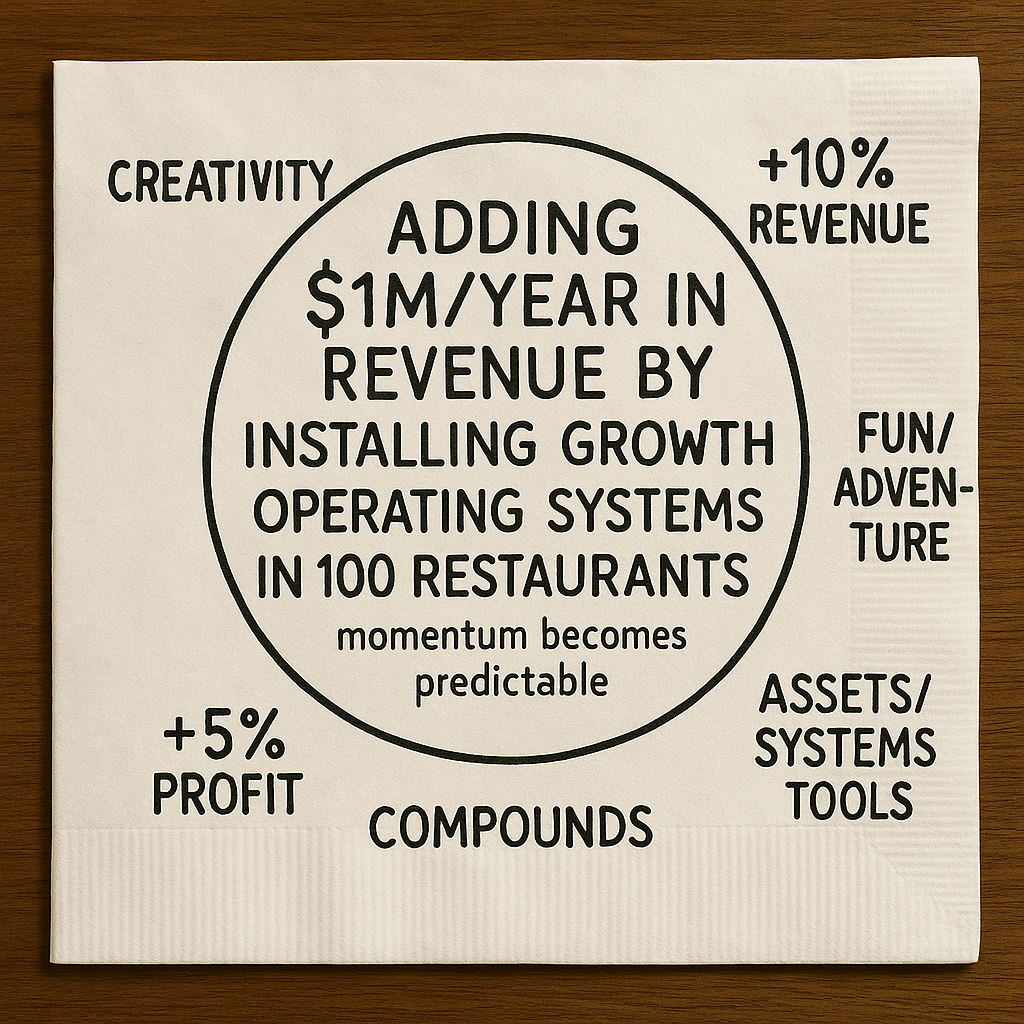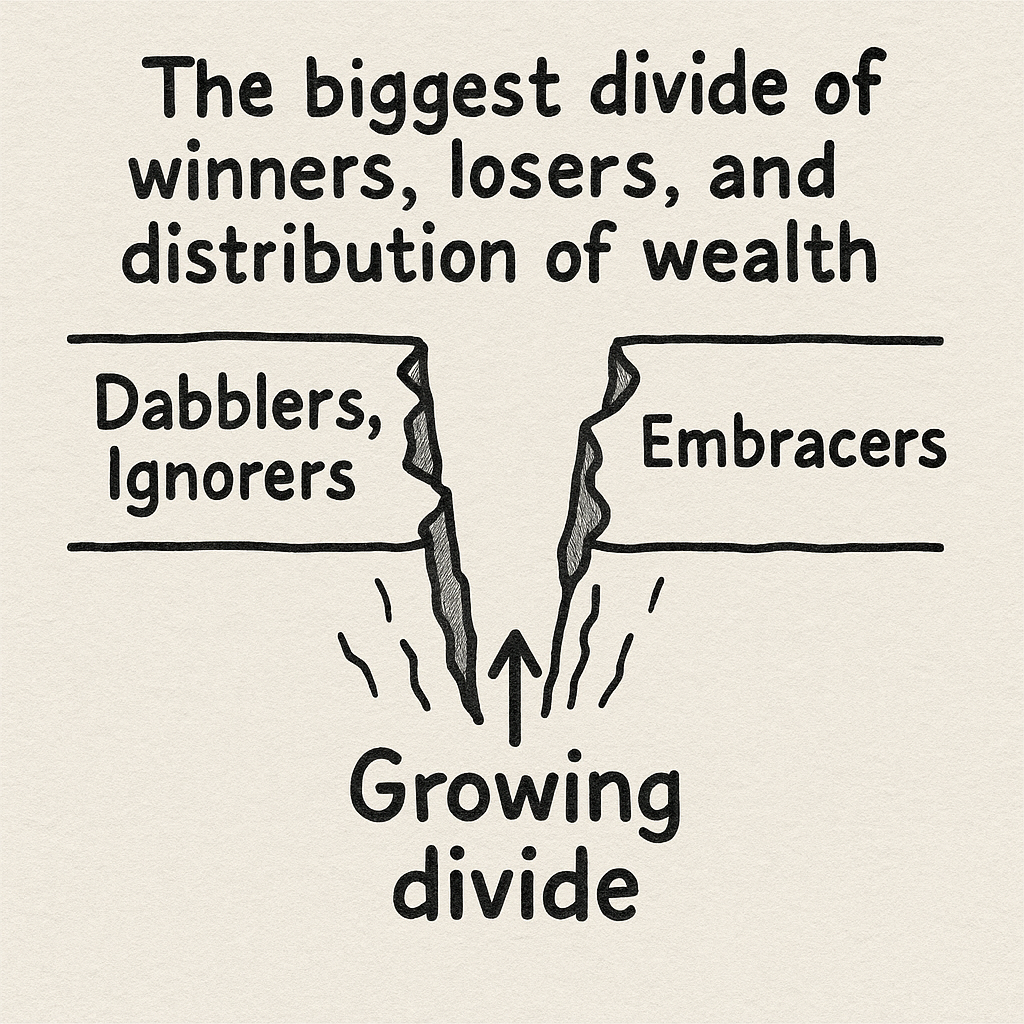I’m building a $1M/year business by deploying Growth Operating Systems in 100 restaurants—each designed to grow revenue 10% and profit 5%—in the next 18 months.
I’m documenting every move—so momentum becomes predictable, growth compounds, and owners stop feeling like they’re guessing.

Since 2018, I’ve been getting clarity on what keeps restaurant owners up at night.
Things like:
- “I feel like I’ve been on a sinking ship for 16 years.” (How the hell do you get off a sinking ship?)
- “I just ran every report every which way and couldn’t find any correlation between booking and marketing spend.” (How do you make decisions when you have no idea what’s working?)
- “It's a pain in the ass, let me tell you. And it's hard, right? Cuz there's so many moving parts to the whole thing.” (How do you not feel overwhelmed and burned out?)
When I started in this game, I was keen to get results however I could.
Now? Sure, results, but what I REALLY want is to solve these major problems for restaurant owners:
- Major Problem 1: The vehicle they’re in doesn’t feel efficient and effective. Or it isn’t firing on all cylinders.
- Major Problem 2: They have no idea what’s working and what isn’t, so decisions can feel like gambling .
- Major Problem 3: It all feels like a mess (so tire spinning, overwhelm, burnout, irritability)
And even though I’ve been at this game for 7 years, I don’t have solutions to these problems.
(Spoiler: no one does)
But I’m determined to get them in the next 18 months 😈 (lest I become a generic AI consultant 🤢)
Now that you know what I’m up to, let’s remind ourselves:
We’re entering the biggest skill divide since the tractor.
This is a juicy time. We all know that.
We are in the middle of a revolution.
And it’s not the first time tools changed everything.
Up until the early 1900s, it could take dozens of people—plus horses or oxen—to plough a single field.
Then came the tractor.
One person could do the work of 20–50.
Some of those people threw up their hands: “Welp, guess I can’t plough fields anymore.”
Others mastered the tractor—operating it, building it, teaching it, adding to it, etc.
Who do you think the winners were?
And as the saying goes: history repeats itself—because we forget it.
(I recently heard someone call the U.S. “the United States of Amnesia.” lol)
Every ~80 years, a major war breaks out—not just because of politics, but because the generation that remembers its horror is gone. Memory fades. So history loops.
The tractor is just one example.
- Horse and buggy → Car
- Candle → Electricity
- Film → Digital
- Map → GPS
- Landline → Smartphone
- Cash register → iPad POS
Every time, people panic.
Every time, someone adapts and builds the new system.
And every time, those folks win for a generation.
Today, more than 80% of jobs involve sitting at a computer.
And most of that work is still being done like we’re ploughing fields by hand.
Click by click.
Some will keep clicking—business as usual. Others will master the new tools and systems.
It’s important to choose the right side of this divide:

And even though we generally think of restaurants in terms of food, experience, service, ambience, etc—A LOT of those manual computer activities are critical to the business.
This is the moment to choose!
Here’s what’s insanely exciting to me about all this in the restaurant space:
In a typically “low margin” business →There are cost centres that can be eliminated (or even flipped into profit centres) and revenue drivers that can be accelerated—practically over night.
TL;DR: The tools that used to feel like overhead are now levers. When systemized, they grow revenue and protect profit.
Here are just a few restaurant Cost Centres and Revenue Drivers—all of which happen at a computer (at least in some manner):
| Cost Centres 📉 | Revenue Drivers 📈 |
| Reporting | SEO |
| Scheduling | Email Marketing |
| SOPs | Reputation (incl. Reviews) |
| Accounting | Ad Building |
| Inventory | Loyalty |
| HR / Onboarding | SMS / CRM |
| Equipment / Tech | Events & Catering |
| Training | Birthday Program |
And these can be expensive.
In an industry practically defined by “low margins,” AI creates opportunity to not just make restaurants work a bit better, but to turn them into highly attractive wealth vehicles.
You know, the kind that…
- Franchisees want to own
- Investors want a piece of
- Successors want to buy and take over
The initial goal? Soooo simple:
- Reduce cost centres so that we find 5% more profit
- Accelerate revenue drivers so that we find 10% more revenue
That’s it.
Why 10% and 5%?
It’s arbitrary but enough to be meaningful.
Here’s how the math shakes out for restaurants ranging from $500K - $5M per year in revenue.
| Original Revenue (Mo) | New Revenue (Mo) | Added Revenue (Mo) | Original Profit (Mo) | New Profit (Mo) | Added Profit (Mo) |
| $41,667.00 | $45,833.00 | $4,167.00 | $4,167.00 | $6,875.00 | $2,708.00 |
| $83,333.00 | $91,667.00 | $8,333.00 | $8,333.00 | $13,750.00 | $5,417.00 |
| $125,000.00 | $137,500.00 | $12,500.00 | $12,500.00 | $20,625.00 | $8,125.00 |
| $166,667.00 | $183,333.00 | $16,667.00 | $16,667.00 | $27,500.00 | $10,833.00 |
| $250,000.00 | $275,000.00 | $25,000.00 | $25,000.00 | $41,250.00 | $16,250.00 |
| $333,333.00 | $366,667.00 | $33,333.00 | $33,333.00 | $55,000.00 | $21,667.00 |
| $416,667.00 | $458,333.00 | $41,667.00 | $41,667.00 | $68,750.00 | $27,083.00 |
The impact is especially meaningful across multiple locations.
Knowing the tools isn’t enough. You need a system that uses them for you: The Restaurant Growth OS
Most restaurants don’t need more:
- Content
- Influencers
- Ads
- Emails
- Etc
What they need is more clarity.
Clarity into what moves the needle and what doesn’t.
That is what building The Restaurant Growth OS is meant to do.
In my next post, I’ll break down what this OS looks like—starting with the Personal Heads Up Display (HUD) of the owner. It’s one of the most valuable system layers we’ve built.
“Businesses don’t die because they run out of money, they die because the founder runs out of energy.”
‘til soon,
Kyle
P.S. You’ve probably already tried posting more, running ads, or asking for more reviews.
That’s not the issue. The issue is: there’s no system catching and compounding the upside.
Besides the fact most marketers are unwitting charlatans—the landscape has changed so dramatically that we must put full-fledged business engineering hats on. It’s no longer enough to just be a marketer.